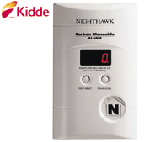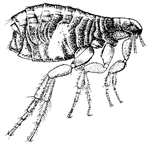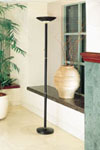The Six Silent Killers in Your Home: How to Detect and Eliminate Them
by SixWise.com
You routinely check the batteries on your smoke detectors. You keep your doors locked with a deadbolt. You are particular about turning your oven off after each use.
Yet despite the fact that most Americans believe their homes are safe havens, of the 91,000 deaths that occur each year from unintentional injury, 20 percent of them occur in the home, according to The Home Safety Council. This translates to about 18,000 deaths each year from home injuries.
A majority of these fatalities in the home are due to "invisible" threats that you cannot see, smell or feel until an accident occurs.
Even those with the best intentions of home safety can easily overlook these serious threats … that is, unless you are aware of them and take the proper steps to eliminate and avoid them.
With that in mind, here are the top six silent threats in the home and what to do about them. who should also be aware of this important information.
1. Don't Let Harmful Gases Sneak Up on You
Carbon Monoxide
- If you don't already own a carbon monoxide detector, investing in one could save your life—this poisonous gas is responsible for killing almost 4,000 people in the United States each year. Because carbon monoxide (CO) is an invisible, odorless gas that is produced when fuels from your fireplace, water heater, boiler or furnace burn incompletely, it can fill a home, and your lungs, without anyone taking notice. Once exposed, symptoms include headaches, nausea, dizziness, fatigue, shortness of breath, unconsciousness and even death.
- Carbon monoxide detectors are the only way to detect the gas in your home, which is why several states and cities have implemented legislation requiring them in new dwellings (if you live in Chicago, St. Louis or New York City, you're in luck). Sixwise.com strongly recommends investing in a high quality, reliable carbon monoxide detector.
After research and careful review, by far the most highly rated line of carbon dioxide detectors we found are those by Kidde Nighthawk, and one that is particularly recommended is the Kidde Knighthawk Carbon Monoxide Alarm Kopp-3. This alarm plugs into any standard wall outlet and offers superior protection from two threats -- carbon monoxide AND explosive gas (see below).

The top-rated Kidde Knighthawk Carbon
Monoxide Alarm is UL approved & provides
peace of mind that your home is free of the
poisonous, odorless gas.
Read More Now
|
Gas Leaks
- Leaking gases from stoves and heaters can lead to asphyxiation (the inability to breathe leading to suffocation) and dangerous explosions. Fortunately, most commercial gases used in homes have a strong odor added to them to alert you of leaks. If you smell a gas leak, immediately get out of the home and call the police or fire department (if you are unable to leave, open the windows and doors and shut off the gas supply if you know where it's located before getting help. Also avoid turning on lights or electrical outlets, which could spark an explosion).
Radon
- Radon is an odorless radioactive gas that comes from rocks, well-water and building materials beneath your home. According to the Environmental Protection Agency, it's estimated that up to 30,000 lung cancer deaths occur each year due to household radon exposure—the greatest cause of lung cancer in the United States second only to smoking.
- The only way to detect radon in your home is with a radon gas detector kit that can accurately measure harmful levels in your home. The Professional Radon Gas Dual Canister Test Kit is reasonably priced, easy to do and provides you test results in the same day.
2. If Your Home is Sick, You Could be Too: Fungi and Mold
- Sick Building Syndrome (SBS) results when indoor air becomes contaminated with fungi, or mold. The mold can grow when walls, carpets or other building materials become wet and aren't adequately cleaned.
- According to Dr. David Straus, a scientist from Texas Tech University and a leading expert on mold exposure and SBS, the usual symptoms of SBS include eye, nose and throat irritation, headaches and fatigue.
- Signs that your home may be mold-infested include:
- Stained ceilings
- A musty or earthy smell
- Black, pink, orange or green spots on walls
- Flood or hurricane damage
- Swollen or crumbling walls
- Damp basement
- Leaky pipes, ceilings or toilet seals
- Dr. Straus gives the following recommendations to keep your home mold-free:
- Make sure your home has no broken pipes or leaks in the roof (these could promote mold growth)
- Reduce humidity in your home my weather-proofing it as much as possible
- Keep furniture and floors dusted
- Change air filters regularly
According to the Centers for Disease Control, the following groups of people may be at greater risk than others for mold:
- Infants and children
- The elderly
- People with asthma, allergies, and other respiratory (breathing) conditions
- People with weakened immune systems (such as people with HIV infection, cancer patients taking chemotherapy, and people who have received an organ transplant)
When working around mold in the home, it is highly recommended that you wear gloves made natural rubber, neoprene, nitrile, polyurethane; wear goggles that do not have ventilation holes; and keep your mouth covered with a multi-purpose respirator.
If you suspect mold in your bathroom shower, an excellent remedy is to combine 2 teaspoons of tea tree essential oil (Melaleuca alternifolia) with 2 cups of water in a spray bottle and shake well. The mixture can be sprayed directly onto problematic surfaces like tubs and shower curtains. "Nothing works as well as this mixture to remove mold," says Berthold-Bond, an environmental home expert.
For home dusting, it is recommended that you avoid common rags as they are some of the prime havens for germs and tend to merely spread microscopic contaminants like fungi around. Instead, choose a duster made of ultramicrofibers, which pick up absolutely everything in their path and don't let it go … seriously consider the highly recommended PerfectClean Flexible Duster, which makes it easy to reach any area of your home and is very economical.
IMPORTANT! If you suspect you have a serious case of mold in your home, SixWise.com urges you to read the complementary .pdf e-report from the Environmental Protection Agency called "A Brief Guide to Mold and Moisture in Your Home" at EPA Mold Guide.
3. Illness-Causing Bacteria and Viruses: Lurking in Your Home?
If you read "Your Office is a Top Source of Illness-Causing Germs to You!" on Sixwise.com, you know that germs that cause flu, diarrhea, and considerably more serious contagious diseases abound in places you least expect them—the typical home or work office desk, for instance, has 400 times more germs than a toilet! And there are more germs in your kitchen than in your bathroom!
While many people diligently scrub and disinfect their bathrooms, it's easy to overlook a desktop or kitchen counter that appears clean. What you don't see, however, are the microscopic, illness-causing germs that have taken up residence on your computer keyboard or kitchen sink drain.

Prevent the Dangerous Pests You Can See, Like Fleas, and the Dangerous Pests You Can't See, Like Viruses and Bacteria, by Keeping Your Home Clean at the Microscopic Level
|
Another highly overlooked area of the American home? Children's areas. This includes their toys, which should be cleaned routinely with a safe ultramicrofiber product but rarely are cleaned with anything at all.
Americans typically spend about $1 billion each year on antibacterial products to kill household germs, yet many experts say these products give out a false sense of security, as they only kill bacteria—not the viruses that are responsible for many illnesses.
This is why Sixwise.com so highly recommends you use PerfectClean products in your home office, kitchen, children's rooms —anywhere you want the deepest clean, down to the microscopic level.
PerfectClean is what the hospitals, schools, fine hotels and other leading organizations are now using to safely keep their facilities "microscopically clean," and you and your family don't deserve any less.
PerfectClean's ultramicrofiber construction combined with a patented antimicrobial chemistry enables its wipers, towels, & flat mops to reach deep into microscopic crevices and remove everything in its path … that is because at an astonishing 3 microns, the ultramicrofibers are even smaller than most bacteria (each cleaning cloth contains over 300 miles of actual cleaning surface!).
Without using any harsh chemicals -- which can not only harm surfaces but can also be harmful to your health (see below) -- PerfectClean products are like magnets to dirt, dust and biological contaminants. Plus, hospitals and other organizations in the commercial industry use each PerfectClean cloth over 100 times, simply washing them in the washing machine, and you can too! You will SAVE BIG by eliminating paper towels, germ-infested sponges and rags, chemical cleaners and more by using PerfectClean.
To learn more about PerfectClean products, read The Missing Link to Your Preventive Healthcare.
4. Household Chemicals Can be Deadly

PerfectClean Products Like this Flexible Duster
are Made of 100% Safe Ultramicrofibers That
Pick Up Everything in Their Path – So You
Can Eliminate Germ-Infested Rags and
Dangerous Chemical Cleaners!
Read More Now! |
Many household products -- including those meant to clean, disinfect, fertilize, kill insects and rodents, and more – are poisonous at varying levels to humans and pets. If these products fall into the wrong hands (or mouths), they can quickly turn from "helpful" to harmful and horrific. Therefore:
- Keep all chemicals, including cleaners, insecticides, antifreeze, medications and vitamins, fertilizers, herbicides, pesticides, etc. in child-proof containers that are out of the reach of children and pets.
- Consider switching from chemical cleansers to the 100% PerfectClean products covered in the section above. Not only are they significantly more effective, but they are far more cost-effective too as hospitals and other organizations use PerfectClean towels, wipers and more a hundred times or more to full effect before replacing!
5. Keep Pests at Bay
Though mildly to severely disgusting, many pests that can invade your home are relatively harmless. However, there are some pests that can pose a variety of serious dangers.
Mice: As you are urged to read in full at "Hantavirus: The Little Mouse in Your House Could Be Deadly!" two varieties of mice common in North America are responsible for Hantavirus pulmonary syndrome (HPS), a very serious disease of which 50% of the cases in humans result in death. The key to avoid hantavirus in your home is to keep it thoroughly clean, and to use highly effective traps if you do have mice such as the top-rated Victor Electronic Mousetrap.
Termites: Though more a nuisance than a real health hazard, termites can cause major structural damage to homes (and to your wallet). If you suspect you have termites, it is important to contact a professional exterminator as soon as possible.
Red Fire Ants: Red fire ants, which were once confined to South America, have infested many Southern and Southeastern states. Fire ants are so dangerous because, similar to bees, when a mound is disturbed the ants have a "mob mentatlity" that causes them to attack in swarms. When humans are bitten, the ant venom burns the skin and causes tiny blisters to form. Fire ants bite repeatedly, leaving victims with blister-covered skin.
Rats: Rats, which often have fleas, can spread dangerous diseases. Plus, they like to gnaw through all kinds of materials and can even start fires if they chew on electrical wires. The Victor Electronic Rat Trap is highly recommend to get rid of rats in your home (it is safe, reusable and it's not disgusting like other methods!)
Fleas and Ticks: Fleas and ticks are everywhere—there are more than 200 species of fleas and 200 species of ticks in the United States—and they can transmit diseases like Lyme disease, ehrlichiosis, babesiosis and Rocky Mountain spotted fever to pets and humans alike. According to the Centers for Disease Control and Prevention, more than 16,000 Americans are infected with Lyme disease carried by deer ticks every year, and often the ticks come into the home via pets. There are a variety of approaches on the market to rid your home of fleas and ticks, but if you have a severe infestation it is highly recommended that you contact a professional exterminator.
6. Hidden Fire Hazards
According to the U.S. Fire Administration, every year, nearly 156,000 fires in the U.S. occur during the winter holiday season, claiming nearly 630 lives, and many are caused by accidents. Even the recent well-publicized skyscraper fire at the LaSalle Bank headquarters in Chicago, which injured more than three-dozen people and burned for over five hours, was reportedly caused by an accident.

Halogen Torchére Lamps Can Be
a Serious Hidden Fire Risk.
|
Hidden fire hazards that many people are unaware of include:
- Worn out extension cords
- Unattended candles, cooking pots or indoor Christmas lights
- Cigarettes that are not put out completely
- Damaged cables
- Halogen torchére floor lamps: The halogen bulbs in these lamps operate at extremely high temperatures that can ignite nearby drapes, bedding or other flammable objects unless the lamps have a wire or glass guard and a bulb that is 300 watts or less.
You may not want to risk having one of these lamps in your home at all, but if you have a Halogen torchére lamp and wish to keep it, you can and should get free wire guards by writing to:
Catalina Lighting Consumer Services
18191 NW 68th Avenue
Miami, FL 33015
Sources
The Missing Link to Your Preventive Healthcare: PerfectClean!
The Home Safety Council
Home Safety
CBS News: "Silent Killers: Is Your Building Sick?"
Natural Health, September 2003
Danger Lurks in Your Home and Garden!